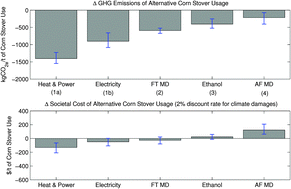Environmental and economic tradeoffs of using corn stover for liquid fuels and power production†
Abstract
Using agricultural residues, such as corn stover, as feedstocks for liquid fuel or electricity generation has the potential to offset anthropogenic climate impacts associated with conventional utilities and transportation fuels. In this paper, the environmental and economic costs and benefits associated with the usage of corn stover for different applications are calculated. Combined heat and power (CHP), ethanol, Fischer–Tropsch (FT) middle distillate (MD) fuels (i.e. diesel and jet), and advanced fermentation (AF) MD fuels are considered. The net societal costs or benefits of different corn stover usages are calculated as the difference between the sum of monetized greenhouse gas (GHG) emissions and the supply costs of a certain corn stover usage, and the sum of these metrics for the conventional commodity that is assumed to be displaced by the renewable alternative. Uncertainty associated with the analysis is captured using a Monte Carlo approach. It is found that corn stover derived electricity and fuels, compared to their conventional counterparts, reduce GHG emissions by 21–92%. The mean reduction for electricity in a CHP plant is 89% compared to the US grid-average, 70% for corn stover ethanol compared to conventional US gasoline and 85% and 55% for FT MD and AF MD compared to conventional US MD, respectively. Mean supply costs for corn stover-derived utilities and liquid fuels are ∼9% and ∼1% lower than the conventional counterparts for electricity and FT MD, respectively, and ∼45% and ∼300% higher for ethanol and AF MD, respectively. Using corn stover for CHP yields a net mean societal benefit of $131.23 per t of corn stover, which decreases by two-thirds if only electricity is produced, while FT MD production presents a mean societal benefit of $27.70 per t of corn stover. Using corn stover for ethanol and AF MD results in a mean societal cost of $24.86 per t and $121.81 per t of corn stover use, respectively, driven by higher supply costs compared to their conventional counterparts.


 Please wait while we load your content...
Please wait while we load your content...